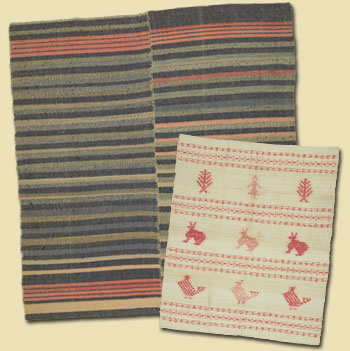François Séguin dit Ladéroute
and Jeanne Petit.
Marriage to Jeanne Petit.
Growing up in the Atlantic port city of La Rochelle Jeanne Petit dreamt of boarding one of the ships sailing to the New World. She was the daughter of Jean Petit and Jeanne Gaudreau. At age 16, the intrepid young woman joined 14 other filles du roi aboard La Nativité. Their two month trek first landed them in Québec on 3 August 1672, before moving further upriver to Montréal. There, she disembarked to be sheltered by the Sœurs de la Congrégation until a suitable match was found for her.
Jeanne signed a marriage contract with François Séguin dit Ladéroute on 21 September 1672, and the two were wed on 31 October in the wooden church in Boucherville. There they settled in to raise their large family. Their first-born, our ancestor Françoise, was born 1 November 1674 and she was baptized the same day in Boucherville. Soon after contracts to lease cows appear in notarial records, perhaps to provide milk and cheese for his children.
Tisserand.
In the 1681 census of Boucherville, François, 33, declared he was a tisserand, or weaver. He and Jeanne, 25, had four children: our Françoise, 7; Madeleine, 5; François, 3 and Jeanne 1. They had a cow and had developed about six arpens of land at the western edge of the settlement.

to attain the desired width. The Boutonné
style baby blanket features trees and bunnies.
Though intricate tapestries were produced in France, the frontier required more practical fabrics. Material was imported to trade for furs and fish, though these could be expensive. In time locally grown flax or hemp and wool from sheep was available to spin but the thrifty habitant, of necessity, learned to weave floor cloths and bed coverings by recycling old cloth torn into strips.
A simple loom was employed. Bed coverings produced à la planche (on a narrow board) were patterned with a block design. Catalogne weavings of colorful bits of rag cloth torn into strips were woven through la chaîne (warp) to make durable striped bed coverings and rugs. Boutonné involved pulling colorful strands of la trame (weft) to shape simple motifs such as pine trees or stars.
In the End.
Their daughter Françoise married a man from Longueuil in 1694.
François was 56 years old when he died in Hôtel-Dieu de Montréal on 9 May 1704 and was buried the next day. His family came into a bit of a windfall when his old commander passed away in 1709. Pierre de St-Ours, chevalier de l'Ordre militaire de St-Louis, bequeathed a sum to his former soldiers of which Françoise was entitled to 50 livres.
Jeanne Petit, 77, died on 29 March 1733. She was in Longueuil where three of her daughters lived .
View the family on the Boucherville Map, next, then on that page choose Françoise Seguin and Charles Patenaude from the menu on the right.
- Jetté, René, Dictionnaire généalogique des familles du Quebec des origines à 1730 (Montréal: Les Presses de l'Université de Montréal, 1983)
- Dictionnaire généalogique des familles Canadiennes depuis la Fondation de la Colonie Jusqu'a Nos Jours, Tanguay, L'Abbé Cyprien, Baltimore: Genealogical Publishing Company, 1967
- https://commons.wikimedia.org/wiki/Category:Rolle_des_Soldats_du_Regiment_de_Carignan_Sali%C3%A8re_qui_se_sont_faits_habitans_de_Canada_en_1668), originally taken from champlain2004.org
- 1681 census at Contrecœur Ste-Trinité // Ft St Louis (p61)
- Searching Through Old Records… p60 August 6th (1665) The burial of [Pierre] Cuoc dit Lafleur, 41, one of M. de Froment's soldiers, who married Marie Mite8ameg8k8e in Trois-Riviéres. He had been shot accidently by one of his companions. "Occusus glande catapultae fortuito â socio" / "Killed with a lead projectile catapulted by an ally"
- Notes Archeologiques; Le Fort de Chambly; 1709 a 1760; p1-3
- Faillon - Vie de la sœur Bourgeoys, fondatrice de la Congrégation de Notre-Dame de Villemarie en Canada, suivie de l'histoire de cet institut jusqu'à ce jour, Tome I, 1853 (illustrion p 206).png
- https://www.migrations.fr/
- www.geocities.com/~carignan/09_Nav_Carignan/E9nav_car.html
- Jefferys, Charles W. 1942; The Picture Gallery of Canadian History Volume 1, p.199: Fort Chambly; Library and Archives Canada, No. 1972-26-756
